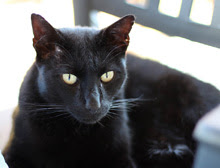I've been experimenting with my camera again. Digital cameras have all kinds of features that go unused, I'm sure, just because there are so many of them. Changing settings requires first, knowing that they're there, and second, having the time to adjust the camera before pressing the shutter release.
I think I'm like many people in that I have my camera set up for basic stuff, and only make minor adjustments while taking photos. I've recently noticed that I have a feature that will take images in TIFF format. These are really big photos, ten times the size of the standard six megapixel image I normally take.
The documentation for my Panasonic Lumix camera says that the TIFF image is best for when you are printing a picture or when you want to do an extreme crop and enlarge a small portion of your image. Trouble is, when I'm out taking photos, I don't really know what I'm going to do with them later, so I never think to change the setting.
Yesterday I took some pictures of the bookshelves in our guest room/den in the larger format just to see what I could see. The standard JPEG images came in at 1.5 megabytes, and the TIFF format images came in at over 15 megabytes. But I really couldn't see many significant differences on the computer screen.
When I take standard photos, my one gigabyte storage card can hold well over 300 photos. In TIFF mode, I can only get about 55. I suppose if I'm taking portraits or long shots, it might be worth switching to TIFF mode. I'll try to keep that in mind.
Tuesday, January 05, 2010
Subscribe to:
Post Comments (Atom)










I just checked my camera and it has a TIFF mode too. Who knew? I don't know what most the settings do, but I know I sure love your pics.
ReplyDeleteI LOVE the book photos! Love them!
ReplyDeleteI hope we'll see pictures of your Fête des Rois event... fève, crown, gallette... if we do, I'll be putting some of them on my slide show at school :))
Nadège, if you write me from my web page "contact form", I'll send you my email address :)
Judy
I'm afraid I like to just point and click. Leon fiddles around with the camera for ages, and we laugh that by the time he takes the photo, his subjects have walked away. He really does take good ones, I'm just lazy.
ReplyDeleteWalt...on your shelf of travel books, there are no Australian ones!!! We think it's time you both came here for a visit! Get on it.
Sue
The big difference is that TIF files are not compressed and JPG are. That's why there's a difference in the size of the files.
ReplyDeleteThe important thing is to compose properly in the camera. Even if you do some cropping you won't see a difference that warrants using TIF files.
For all practical purposes, you are not going to see a quality difference unless you open a file, edit it, save it, open it, edit it, save it.... several times. The JPG compression will begin to fall apart after 5 or 6 generations and you will start to see the quality difference. I've had photos that are life size (6' high and 4' wide) printed from JPGs with no problems.
How organised you are...grouping your books according to subject matter! Other than my complete collection of Agatha Christie books being aligned all else is shelved mostly according to height.
ReplyDeletelarry, thanks. I, too, am confused by all the settings!
ReplyDeletejudy, I'll try. I'm making the galette today.
sue, I would love to visit Oz one day!
tom, I've come to that conclusion and am glad to get your impression. I'm sticking with jpg's for now!
victor, retirement. It's 24/7. ;)
My little Canon PowerShot has nine settings, of which I use three. But I'm not a real photographer, so it doesn't really matter, does it?
ReplyDeleteA lot of the differences in formats are down to printing requirements. For display on the web, most people's browsers will display at a much lower resolution anyway, so for most practical purposes you can't really change what they see by varying the technical format of the image.
ReplyDeletestarman, if you take pictures, then you're a real photographer in my book!
ReplyDeletepatrick, yes, I'm understanding that better now.